Viburnum leaf beetle now in Michigan
An invasive pest, the viburnum leaf beetle threatens viburnums in natural and landscape settings.
For several years we’ve been keeping a watchful eye on the viburnum leaf beetle, which heavily feeds on viburnums in native and landscape settings. We’ve monitored its movement across northeast states and into Ohio, watching it get closer and closer to Michigan and hoping we wouldn’t have yet another invasive pest.
The viburnum leaf beetle, a European native, has made it to Michigan. In fact, there were two previous sightings in Chippewa (2003) and Genesee (2010) counties and viburnum leaf beetle is now confirmed in Oakland County. Michigan State University entomologist Howard Russell feels viburnum leaf beetles may be more prevalent in Michigan than we think, so keep an eye on your viburnums.
Hosts
Viburnum leaf beetle feeds only on viburnum species. Preferred species include the popular arrowwood viburnum (V. dentatum), European cranberrybush viburnum (V. opulus), American cranberrybush viburnum (V. trilobum), and Rafinesque viburnum (V. rafinesquianum).
Other viburnums known to serve as hosts include Sargent viburnum (V. sargentii), wayfaringtree viburnum (V. lantana), nannyberry viburnum (V. lentago), and blackhaw viburnum (V. prunifolium).
Particularly resistant species include Koreanspice viburnum (V. carlesii), Burkwood viburnum (V. burkwoodii), doublefile viburnum (V. plicatum var. tomentosum), Judd viburnum (V. x juddii), lantanaphyllum viburnum (V. x rhytidiphylloides), and leatherleaf viburnum (V. rhytidiphyllum).
Viburnum leaf beetle identification and damage
Larvae hatch from overwintering eggs in May. The emerging larvae are greenish-yellow and feed gregariously on the underside of tender, newly expanding viburnum leaves skeletonizing the foliage. Damage usually starts on lower leaves with only the midribs and major veins left intact. As the larvae mature, they grow to about 1/3 of an inch long, darken and develop a series of dark spots.
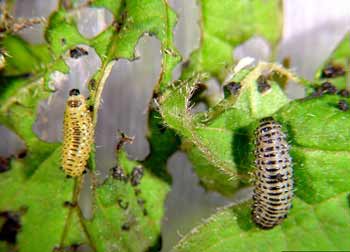
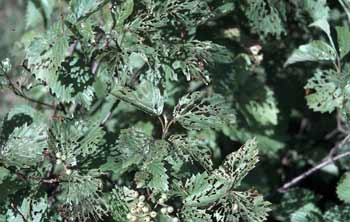
Left: Second and third larval instar. Photo credit: Paul Weston, Cornell University, Bugwood.org
Right: Arrowwood foliage damaged by larval feeding. Photo credit: E. Richard Hoebeke, Cornell University, Bugwood.org
Mature larvae migrate to the soil to pupate. Adults emerge from July-September and return to feed on foliage. Adult feeding damage consists of irregular circular holes and severe feeding can nearly defoliate shrubs once again. When disturbed, the beetles will fly away or drop to the ground. Adult viburnum leaf beetles are 1/4 to 1/3 inch long and are generally brownish.
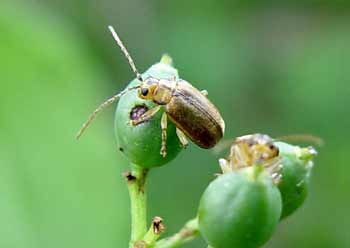
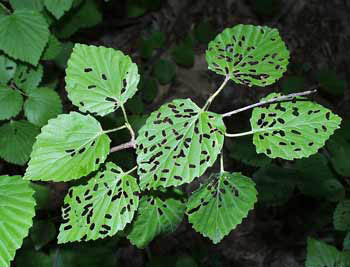
Left: Adult on viburnum fruit. Photo credit: Paul Weston, Cornell University, Bugwood.org
Right: Typical feeding damage by adult on arrowwood viburnum. Photo credit: Paul Weston, Cornell University, Bugwood.org
Adults begin laying eggs in late June to mid-July and continue laying eggs as late as October, until the first killing frost. They prepare laying sites by chewing small holes into a small branch or twig, usually on the current season's growth. The females lay their eggs into the hole and seal the hole with a lid or "cap" made of chewed bark and excrement held together by a special cement that they make.
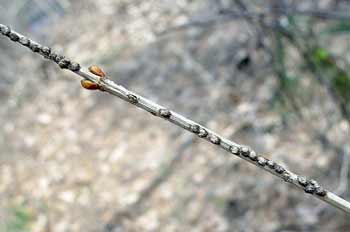
Egg masses on twigs. Photo credit: Paul Weston, Cornell University, Bugwood.org
Economic impact
Heavy infestations by viburnum leaf beetle can defoliate shrubs, cause dieback and eventually kill plants. Valued plantings of the European cranberrybush viburnum can be severely damaged by larval and adult feeding. Shrubs repeatedly defoliated over a period of two to three years are likely to die.
Management
Selecting resistant species, pruning out egg masses, encouraging beneficials and using pest barriers around the base of the shrubs are effective for most home landscapes. When necessary, a number of pesticides are effective in controlling viburnum leaf beetle.
Extensive information on viburnum leaf beetle is available by Cornell University.
Related Source:



 Print
Print Email
Email




